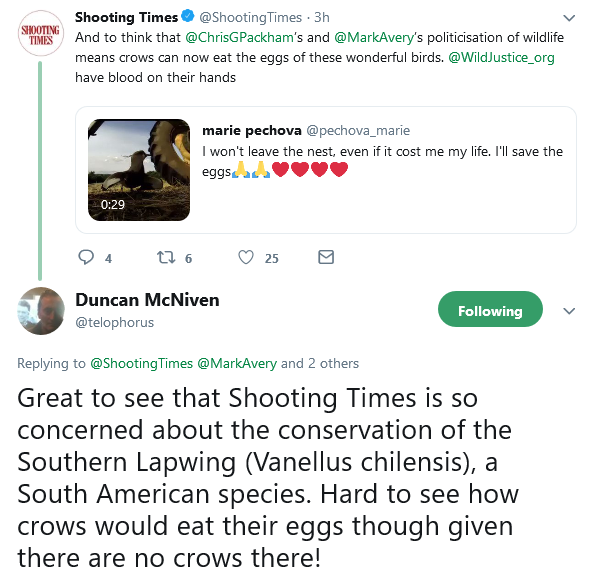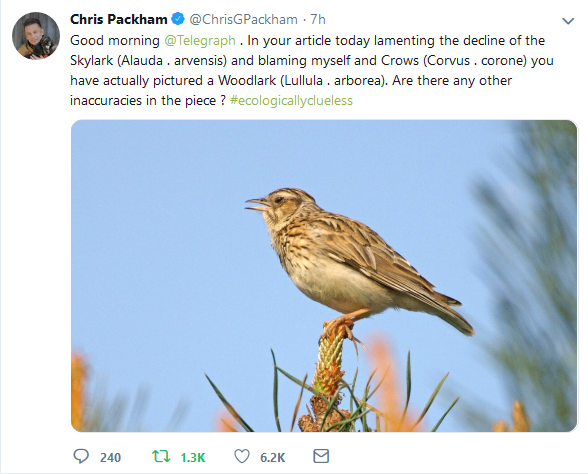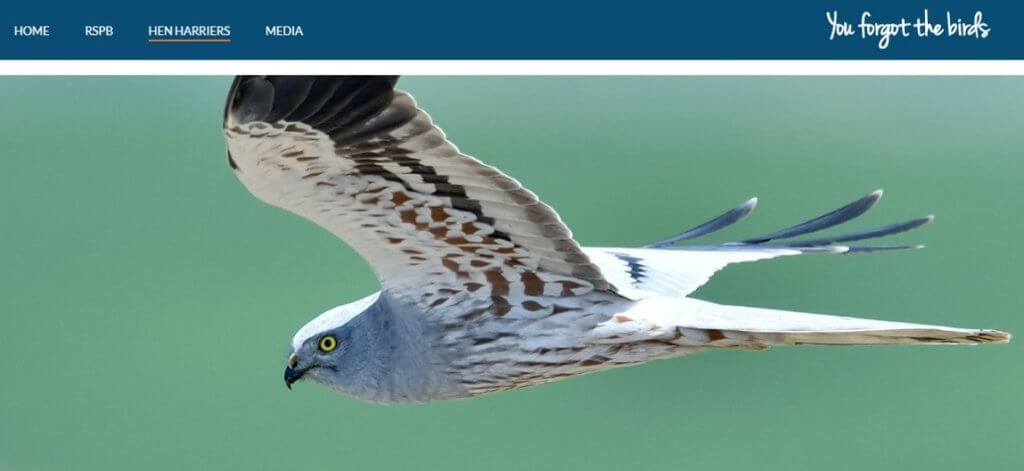Following the success of the Wild Justice legal challenge over the General Licensing system that Natural England has operated, there has been an outpouring of abuse towards anybody to do with this case (and some who have had nothing to do with it) in the press and on social media. But some of the same people have been professing their undying love of birds.
Their enthusiasm for birds is made slightly less convincing since they are often keen to go out again and shoot them but also because their ability to identify birds correctly is sometimes a bit questionable.


A farmer, with whom I agreed (mostly) on BBC Radio Somerset this morning kept telling the world that Rooks were attacking his sheep and pecking their eyes out. I didn’t embarass him on air by pointing out that these were, if anything, Carrion Crows, but they were.
Wild Justice accepts that farmers should be able to protect their livestock from serious damage but would gently point out that an industry that can’t identify birds is in a bad position to kill them under licence.
Luckily, I see that GWCT will flog anyone some advice on the new General Licences on their roadshow – ‘This is your chance to ask our experts about a range of important issues such as the recent changes to General Licences in England.’. Will that include identification lessons? Perhaps it should.
And if it does then YFTB, self-selected spokespersons for countryside folk, still (ie over 6 months after this was pointed out to them) has two images of not-Hen Harriers illustrating its webpage about Hen Harriers. This cracking male Montagu’s Harrier is beautiful, unmistakable and unmistakably not a Hen Harrier. It’s bad enough shooting protected birds but I hope no-one is shooting the wrong protected birds by accident.

Apparently, I have blood on my hands, too. I’ve just been blamed that songbirds will further decline, that pheasant poults will be predated making shooting unviable (leading to hedgerow removal) and the general terror that pigeons and crows will cause in villages because I have apparently colluded with the likes of you. Species on the General Licence are not ever welcome by some people. There was no reasoning with this person who called to shout at me for my supporting role in the Wildlife Justice case. I have had no role, I just know who you are and contributed to case fees (which he doesn’t know). All his supporting evidence was from the Telegraph and Songbird Survival.
SG – I’m sorry that happened to you. Thank you for yur support.
You seem to be a very knowledgable man on birds, perhaps you should broaden your knowledge on farming ie if livestock is having its eyes pecked out that it needs protecting
As you condemn one farmer, please could you let everyone know your thoughts on the domestic cat that kills 55 million birds each year including magpies and jays
Maybe WJ should consult with SS on this issue
Karen A – livestock are protected by the law and Wild Justice doesn’t have any problem with that when properly administered. This isn’t about cats (but, don’t tell anyone, I’m not a great fan…)
cats next
If we reintroduce lynx, especially in leafy green belt areas, then the cat problem solves itself. Another reason to Do It.
That would be a foolish thing to do Lynx is a woodland predator and needs to be in the large areas of continuous woodland and there are few but some areas of the UK with both that habitat and the Roe deer prey base to support it. the data on cats killing so many millions of song birds and small mammals is based on very small sample sizes and probably wide of the mark. I have kept a cat or different cats since the early eighties and the number of birds caught is less than 5 per year. The real problem for all our wildlife is us and the things we do to the environment.
Very much agree, Paul.
I also have lived with cats, all my life (and I am in my 70s) and do not remember any being particularly predatory of birds.
I have a very wild garden now and lots of the usual birds of several species, including a definitely predatory sparrowhawk. So those who dislike wood pigeons will be happy.
Cats and raptors might kill other birds, as it is their nature, but far fewer than humans do – as so many of the contributors to this blog point out.
Maybe you should take the time out to learn a little; then you’d know that SS are as honest as their 1940s namesakes.
It’s positive to hear that you acknowledge that livestock needs protecting and the domestic cat is not your best friend .
I live in Kent and I am not a shooting person but you condemn Grouse shooting .
Are you aware that if this didn’t exist, there would be no heather and no upkeep and therefore no habitat or Grouse and the moors would be full of weeds
I would be upset to see this on my drive home to Perthshire.
I am also a vegan ( like CP) but I do not condemn people who eat meat
Karen A – there was heather in the world before intensive grouse shooting and there will be after it has gone too. There is a book on the subject called Onglorious and written by me. Did you know?
In the beginning there was man. He invented guns. He then invented Red Grouse as flying targets. Thank god for man.
Well put, Paul. (sorry, just lost the like function again).
“Are you aware that if this didn’t exist, there would be no heather and no upkeep and therefore no habitat or Grouse and the moors would be full of weeds”….possibly the most ridiculous uneducated comment I’ve seen on here for a bit!
And it’s those with such woeful education that the SS specifically target.
Personally I would not allow any individual to own a gun. Guns should be held only by an approved and licensed organisation and such licences should be made very hard to obtain.
When individual shooters cannot identify a bird properly, and I am sure thar covers about 99.9% of shooters, then they should not be allowed to operate / fire a gun.
This may sound to some a bit over the top but there are far to many gun owners both in this country and around the world and most of these gun owners are not fit to carry a gun. The number of guns need to be drastically reduced.
I was told by a volunteer at the Argaty red kite centre that in the early days when the red kites were reintroduced that the farm still held a pheasant shoot. It seems that some of the shooters were extremely short sighted and/or their bird ID skills were atrocious because they kept taking pot shots at the kites. They decided to end the pheasant shoot then and there and haven’t looked back since.
Neither should gun licenses be subsidised by the majority of tax payers that would agree with you.
I would think my bird identification skills are far better than most birders thankyou, as is my knowledge of wildlife in general. You are entitled to your opinion of course but as a wildfowler, part time gamekeeper, deerstalker etc I completely disagree with the your entire statement.
Thanks Mark for sharing these treasures.
Flinging dirt so wildly does, even with their experience, look to be a risk that they’ll hit themselves in the face.
Congratulations on Wild Justice’s fantastic win.
I think a sheep with no eyes or intestines would forgive a rook but not a carrion crow
I have always thought that a gamekeepers are hiding behind a licence to kill birds to protect Sheep and crops but what are they really employed to do. Could it be to protect Grouse Deer and Pheasants by any chance so there rich boss can have a few days shooting.
Hi Karen …. Firstly Mark is not a personal friend … but in his defence and others they are quite aware that some legal control of so called vermin birds is needed , they’re just against illegal killing …. also briefly the grouse issue is about protection of the Hen Harrier which is being illegally persecuted by moorland landowners/gamekeepers . As far as I know Mark quite likes birds looking at his CV …. read Inglorious it’ll give you a better understanding … also ‘Feral’ by George Monbiot is terrific and made me realise just what our countryside actually should be … by not eating sheep in particular you really are helping actually.
I am glad that you consider me uneducated and that another blogger refers to woeful education as my blog was put on to elicit such responses and to make the following point: that MA and the recently appointed head of NE have both campaigned against Grouse shooting in the past …
Karen there are many of us who continue to be opposed to driven grouse shooting for a number of reasons:- It is dependent on wildlife crime, in order to achieve the high densities of grouse to make it viable all predators are excluded by killing including those that are legally protected. It is also dependent on burning or cutting heather and keeping much of the habitat a dry as possible to encourage heather growth on what would otherwise be wet heath and Blanket bog. This means Carbon is given off as CO2 rather than sequestered in a growing peat layer. The moors would still be a wonderful picture including the purple heather if it was all rewetted and allowed to develop more naturally. It would be better for downstream flooding and water quality too! Biodiversity would be much better and there would probably STILL BE ENOUGH GROUSE TO ALLOW WALKED UP SHOOTING OR SHOOTING OVER DOGS. Most moorland cannot disappear under conifers or turned to grass moor by high densities of woolly maggots, ( sorry! ) sheep because of their conservation status. There would also be more natural woodland, in time, on the drier parts, much like some of the fantastic heathlands in Norway, Sweden and Finland. We would ALL BENEFIT except the tiny minority of the already wealthy who create ludicrous artificially inflated land values based on the driven grouse bag
I fully agree with your comment “The real problem for all our wildlife is us and the things we do to the environment”, but one of the things we do to the environment is to allow cats to live in that environment and they may be part of the problem, even if in isolation they don’t cause bird declines. There are about 11million cats in the UK, if your cats are ‘average’ then 5 birds per cat per year is 55million birds, that seems rather a lot to me, even if most of those are common bird species, weak or old or post breeding season excess. I work in nature conservation and find more and more that species declines are not often caused by one thing acting in isolation but usually by a number of things acting in combination. So cats are not to blame, but they may be a part of the problem. The
Unlike Mark I do like cats, and my old cat was quite good at catching unwanted rodents in the house. She caught a few more in the garden, the occasional fledgling in spring, and later on proceeded to terrorise the rampant rabbit population around her new home. So far so good.
But I have to recognise both that, unlike some, my cat wasn’t particularly dedicated to bird killing, and that even if there is only a small amount of predation per cat it can still be significant where cat populations are extremely dense. Ie in most of suburbia and most villages too. Given how many birds now rely on gardens I’m not so sanguine about this as I used to be. For unrelated reasons I haven’t had a cat of my own for 15 years, much as I would have liked one, but if I could have another one now I’d have to think twice.
I don’t have a solution but wish as I might I can’t dismiss the issue. Banning cats would deny many people an important companion animal and keeping them indoors overnight goes against their nature. In the end its not really about cats, or dogs – its about too many of us and predation and nest disturbance is just another facet of that.
Some actual data would be handy – about where and under what circumstances cats do have a local population level impact and where they do not. If there is such a study I haven’t seen it.